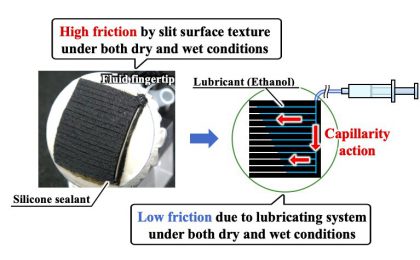
Researchers at Kanazawa University have recently developed a friction reduction system based on a lubricating effect, which could have interesting soft robotics applications. Their system, presented in a paper published in Taylor & Francis’ Advanced Robotics journal, could improve the development of robots that can efficiently manipulate objects under both dry and wet conditions.
Based on news that the searched sources of PIMI have published, for stable robotic grasping, a surface with high friction is required; thus, a soft surface is preferable. In contrast, a slippery surface is preferable for inserting fingers into a narrow space or placing a grasped object on a table. Additionally, in an environment involving humans, such operations are performed under dry and wet conditions. Hence, this study aims at developing a soft robotic fingertip with a friction control system in which the surface friction is actively controllable under dry and wet conditions, whereas the external effects on friction, such as wetness, are minimized. The basic concept involves achieving high friction under both conditions by using a slit surface texture, while friction is reduced with a lubricating system by utilizing capillary action.
“Our previously developed surface texture or skin for soft robotic hands provides high friction under both dry and wet conditions,” Tetsuyou Watanabe, one of the researchers who carried out the study, told TechXplore. “However, this high friction makes several manipulation styles (including releasing and sliding) difficult. In some cases, a grasped object sticks to the surface. To overcome this problem, we developed a new friction reduction system utilizing lubricants.”
When developing their system, Watanabe and his colleagues drew inspiration from human behavior. They observed that in supermarkets people often lick their fingers to open plastic bags or containers. Similar actions are also performed when trying to pick up sheets of paper or turn the pages in a book.
The researchers found that this ‘finger licking’ behavior is particularly common in middle aged or elderly people, as aging typically leads to dryer skin. Younger people, on the other hand, often do not need to lick their fingers when trying to manipulate plastic or paper, because they can automatically control the skin’s friction via their body’s sweat mechanisms.
Read more about this very interesting development at following sources:
Edited and contributed by: S. Marjani
************************
Why Should Be “A Paid-Subscriber” and “Advertiser”
Keeping an independent media in countries that impose limitations on self supporting media, will help to support the humankind’s freedom. If you believe it, please act to be a PRO-MEMBER by clicking “HERE“, or:
Please send your PR’s directly to the email address of the Chief-Editor in order to be published at once in the world via ” http://pimi.ir ” The address is: aasaatnia@live.com.














